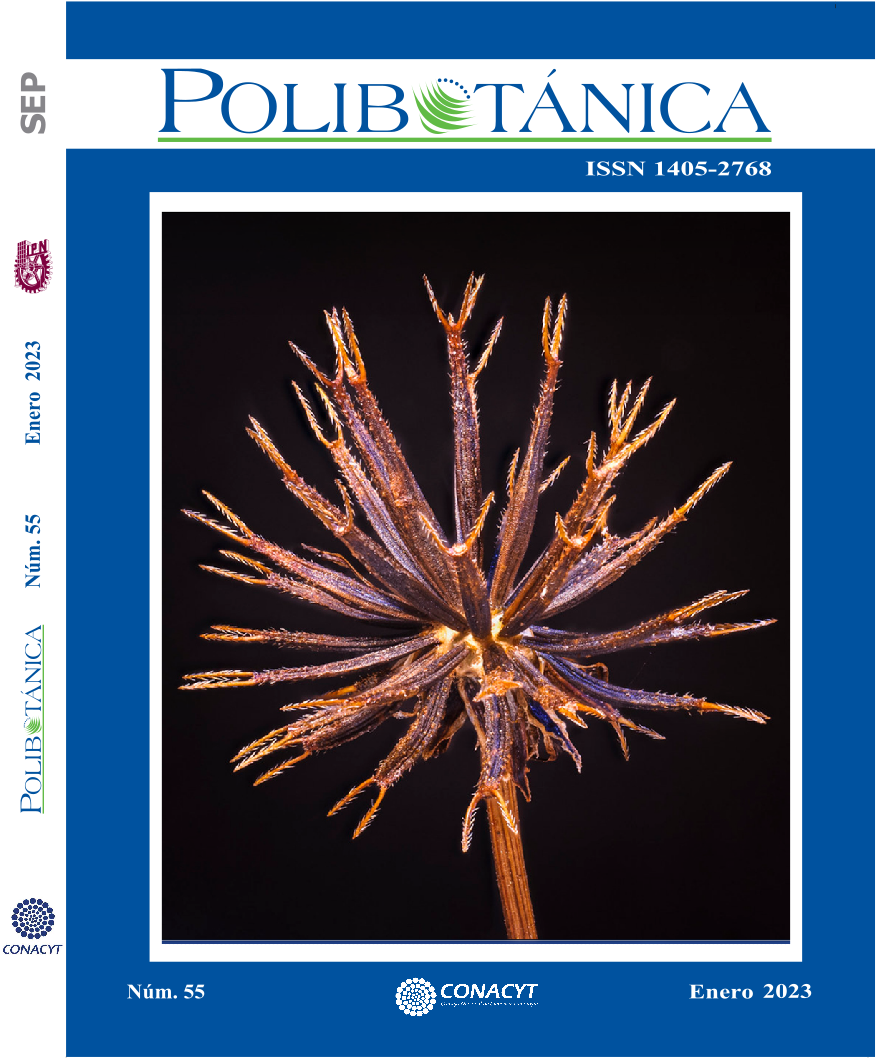Edible wild plants of Aguascalientes, Mexico, their forms of consumption and commercialization
EDIBLE WILD PLANTS OF AGUASCALIENTES, MEXICO
DOI:
https://doi.org/10.18387/polibotanica.55.14Keywords:
acitron; nopales; pitaya; quelite; tuna cardona; useful plants.Abstract
The use of wild plants in the diet of indigenous and rural peoples involves, in many cases, ancestral knowledge which is part of their cultural heritage. For the state of Aguascalientes, a study focused on edible wild flora had not been carried out. The objective of this study was to generate a list of wild edible plant species used in the state of Aguascalientes, their structures used, form of consumption and level of use. From January 2019 to October 2021, a total of 103 people with an age range of 32 to 95 years were interviewed in 26 towns in the state, in addition, street markets and markets in all the municipal capitals of the state were visited to identify the commercialized species. 67 species of wild plants that are used as food in the state of Aguascalientes were identified, of which 25 are commercialized, the main structures consumed are the fruits, stems and leaves. The wild flora is an important economic and nutritional resource for the population of Aguascalientes and some species are used in typical dishes or sweets that are part of the traditions and cultural heritage of the state.
References
Babbie, E. R. (1988). Métodos de investigación por encuesta. Biblioteca de la Salud, Fondo de Cultura Económica.
Barba-Ávila, M. de los D., Croce-Hernández D., M., & De la Cerda-Lemus, M. (2003). Plantas Útiles de la Región Semiárida de Aguascalientes. Universidad Autónoma de Aguascalientes.
Calderón, G., & Rzedowski, J. (2005). Flora Fenerogámica del Valle de México. Instituto de Ecologia, A.C. y y Comisión Nacional para el Conocimiento y Uso de la Biodiversidad (CONABIO).
Carranza González, E. (2008). FASCÍCULO COMPLEMENTARIO XXIII: DIVERSIDAD DEL GÉNERO IPOMOEA L. (CONVOLVULACEAE) EN EL ESTADO DE MICHOACÁN, MÉXICO. Flora del Bajío y de Regiones Adyacentes, XXIII, 1–123. https://doi.org/10.21829/fb.165.2008.XXIII
CONABIO. (2008). La Biodiversidad en Aguascalientes: Estudio de Estado. (1a ed.). Comisión Nacional para el Conocimiento y Uso de la Biodiversidad (CONABIO), Instituto del Medio Ambiente del Estado de Aguascalientes (IMAE), Universidad Autónoma de Aguascalientes (UAA).
Díaz-Luna, C. L., & Lomelí-Sencion, J. A. (1992). Revisión del género Jarilla Rusby (Caricaceae). Acta Botánica Mexicana, 20, 77–99. https://doi.org/10.7818/ECOS.2014.23-2.11
Díaz-Potones, D. (2009). Ipomoea: un género con tradición. ContactoS, 73, 36–44.
Flora of North America Editorial Committee. (1993). Flora of North America North of Mexico [Online]. 22+ vols. http://floranorthamerica.org/Main_Page
García-Regalado, G. (1989a). Plantas Medicinales de Aguascalientes. Universidad Autónoma de Aguascalientes.
García-Regalado, G. (1989b). Plantas medicinales de San José de Gracia, Aguascalientes. Universidad Autónoma de Aguascalientes.
García-Regalado, G. (2014). Plantas Medicinales de Aguacalientes (1a ed.). Universidad Autónoma de Aguascalientes.
García, E. (1964). Modificaciones al Sistema de Clasificación Climático de Koppen (para adaptarlo a las condiciones de la República Mexicana). Offset Larios S.A.
García Hilario, F., Cruz Morales, J., Castro Ramírez, A. E., Hamilton R., T. T., & Pacheco Flores, C. (2016). The crisis of the milpa system: cultural and biological erosion in San Juan de las Nieves, Malinaltepec, Guerrero, Mexico. Revista de Geografía Agrícola, 57, 113–123. https://doi.org/10.5154/r.rga.2016.57.003
Godfray, H. C. J., Beddington, J. R., Crute, I. R., Haddad, L., Lawrence, D., Muir, J. F., Pretty, J., Robinson, S., Thomas, S. M., & Toulmin, C. (2010). Food Security: The Challenge of Feeding 9 Billion People. Science, 327(5967), 812–818. https://doi.org/10.1126/science.1185383
Grundy, A. C., Mead, A., Bond, W., Clark, G., & Burston, S. (2011). The impact of herbicide management on long-term changes in the diversity and species composition of weed populations. Weed Research, 51(2), 187–200. https://doi.org/10.1111/j.1365-3180.2010.00831.x
Guil, J. L., Rodríguez-García, I., & Torija, E. (1997). Nutritional and toxic factors in selected wild edible plants. En Plant Foods for Human Nutrition (Vol. 51). Kluwer Academic Publishers.
Guil, J. L., & Torija, E. (2002). Edible Wild Plants. En D. K. Majundar, J. N. Govil, & V. K. Singh (Eds.), Recent progress in medicinal plants. Vol. VIII. (pp. 431–466). Sci Tech Publishing LLC.
Hernández-Carlos, B., Bye, R., & Pereda-Miranda, R. (1999). Orizabins V−VIII, Tetrasaccharide Glycolipids from the Mexican Scammony Root ( Ipomoea orizabensis ). Journal of Natural Products, 62(8), 1096–1100. https://doi.org/10.1021/np9900627
INEGI. (2021). Principales resultados por localidad (ITER). Aguascalientes. Censo de Población y Vivienda 2020. Instituto Nacional de Estadística y Gografia. https://www.inegi.org.mx/app/descarga/ficha.html?tit=325899&ag=0&f=csv
Khan, F. A., Bhat, S. A., & Narayan, S. (2017). Wild edible plants as a food resource: Traditional knowledge. Division of post-harvest technology Sher-e-Kashmir University of Agricultural Sciences and Technology of Kashmir.
León-Lobos, P., Díaz-Forestier, J., Díaz, R., Celis-Diez, J. L., Diazgranados, M., & Ulian, T. (2022). Patterns of Traditional and Modern Uses of Wild Edible Native Plants of Chile: Challenges and Future Perspectives. Plants, 11(6), 744. https://doi.org/10.3390/plants11060744
Mapes, C., & Basurto, F. (2016). Biodiversity and Edible Plants of Mexico. En R. Lira, A. Casas, & J. Blancas (Eds.), Ethnobotany of Mexico: Interactions of People and Plants in Mesoamerica (pp. 83–88). Springer. https://doi.org/https://doi.org/10.1007/978-1-4614-6669-7
Mares-Guerrero, A. A., & Ocampo-Acosta, G. A. (2018). Catálogo ilustrado de plantas útiles de la Sierra del Laurel, Aguascalientes. Universidad Autónoma de Aguascalientes.
Mascorro-de Loera, R. D., Ferguson, B. G., Perales-Rivera, H. R., & Charbonnier, F. S. J. (2019). Herbicidas en la milpa: Estrategias de aplicación y su impacto sobre el consumo de arvenses. Ecosistemas y Recursos Agropecuarios, 6(18), 477–486. https://doi.org/10.19136/era.a6n18.2076
Molina, M., Morales, R., Pardo de Santayana, M., & Tardío, J. (2009). ¡Láncese al Campo! Plantas Silvestres Comestibles. Tierra y tecnología, 36, 37–44.
Pardo de Santayana, M., & Gómez-Pellón, E. (2003). Etnobotánica: aprovechamiento tradicional de las plantas y patrimonio cultural. Anales del Jardín Botánico de Madrid, 60(1), 171–182.
Pío-León, J. F., Delgado-Vargas, F., León-de la Luz, J. L., & Ortega-Rubio, A. (2017). Prioritizing Wild Edible Plants for potential new crops based on Deciduous Forest traditional knowledge by a Rancher community. Botanical Sciences, 95(1), 47. https://doi.org/10.17129/botsci.772
Pío-León, J. F., Delgado-Vargas, F., Murillo-Amador, B., León-de-la-Luz, J. L., Vega-Aviña, R., Nieto-Garibay, A., Córdoba-Matson, M., & Ortega-Rubio, A. (2017). Environmental traditional knowledge in a natural protected area as the basis for management and conservation policies. Journal of Environmental Management, 201, 63–71. https://doi.org/10.1016/j.jenvman.2017.06.032
Sánchez-Escalante, J. J., & Gilbert, E. E. (2018). Red de Herbarios del noroeste de México: Un esfuerzo colaborativo entre botánicos mexicanos. Árido-Ciencia, 3(2), 21–35. https://herbanwmex.net/portal/
Sandoval-Ortega, M. H. (2020). Contribución al conocimiento de Nymphaea gracilis Zucc. en Aguascalientes, México. TECNOCIENCIA Chihuahua, 14(1), 1–6. https://doi.org/10.54167/tecnociencia.v14i1.561
Sandoval-Ortega, M. H., & Siqueiros-Delgado, M. E. (2019). Plantas útiles de la familia Amaranthaceae en el estado de Aguascalientes. Tecnociencia Chihuahua, 13(1), 40–49.
Sandoval-Ortega, M. H., & Siqueiros-Delgado, M. E. (2020). Jarilla heterophylla, un nuevo registro para la flora del estado y único representante nativo de la familia Caricaceae en Aguascalientes, México. Investigación y Ciencia de la Universidad Autónoma de Aguascalientes, 79, 36–43.
SEINet. (2019). The SEINet data portal. http//:swbiodiversity.org/index.php
Siqueiros-Delgado, M. E., Rodríguez-Avalos, J. A., Martínez-Ramírez, J., & Sierra-Muñoz, J. C. (2016). Situación actual de la vegetación del estado de Aguascalientes, México. Botanical Sciences, 94(3), 455–470. https://doi.org/10.17129/botsci.466
Villaseñor, J. L., & Espinosa-García, F. J. (1998). Catálogo de malezas de México. Fondo de Cultura Económica.
Woodhouse, P. (2010). Beyond Industrial Agriculture? Some Questions about Farm Size, Productivity and Sustainability. Journal of Agrarian Change, 10(3), 437–453. https://doi.org/10.1111/j.1471-0366.2010.00278.x
Zepeda-Gómez, C. (2017). Nymphaeaceae. En A. Lot (Ed.), Plantas acuáticas mexicanas, una contribución a la Flora de México.: Vol. II (pp. 139–153). Universidad Nacional Autónoma de México.
Downloads
Published
Issue
Section
License

Polibotánica by Departamento de Botánica de la Escuela Nacional de Ciencias Biológicas del Instituto Politécnico Nacional se distribuye bajo una Licencia Creative Commons Atribución-NoComercial-CompartirIgual 4.0 Internacional.




















